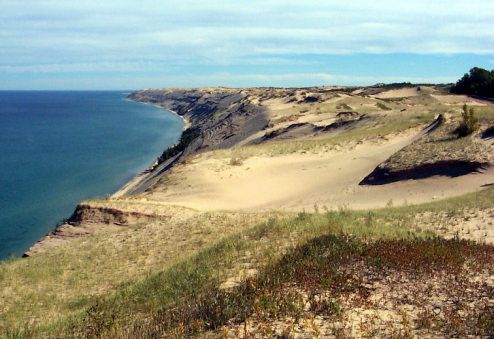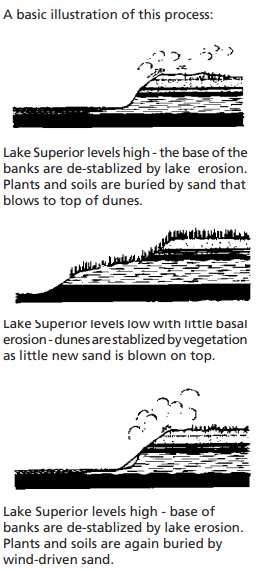Transcript
Pictured Rocks National Lakeshore is well-known for its stunning multi-colored cliffs and beautiful wild beaches. But it has a third main feature that is just as stunning and just as beautiful: the Grand Sable Dunes. The dunes themselves are just the top layer of a large pile of rock rubble and debris left by ancient glaciers, called the Grand Sable Banks. Spanning five square miles, the Banks make up the eastern third of the park. And at 300 feet above Lake Superior, they are also the tallest feature in the lakeshore. Since the dunes are “perched” on top of the Grand Sable Banks, they comprise one of the best examples of a perched dune system in the world. More than just hot, dry sand, the dunes also contain dense jack pine forests and unique plants in their sheltered valleys. What makes this area so special? Let’s walk on the Dunes Trail and find out. The Dunes Trail starts at the far eastern end of the park, near the town of Grand Marais at Sable Falls. Look for the big brown trail sign near the top of the falls. After walking on the trail for a while you may wonder, as you look at the dense forest around you, “Where are the dunes?” Believe it or not, you are standing on them! But these are old, old dunes that have long been claimed and settled by many generations of plants. Newer dunes have open sands that are always changing and shifting. Look above and you’ll see the tall jack pines that dominate these older dunes. Look down and you’ll see that the trail is made of sand, not dirt. Walking on the trail is like walking forward in time, from older to younger dunes. Soon you see bare sand ahead. A quick walk up a sandy slope… and there is the first view of the top of these younger dunes, with open sand mixed with grasses, thickets, and forests beyond in sheltered valleys. If you pick up a handful of sand, you’ll see that all the grains are the same size and color. As waves erode the dune slopes facing the lake, wind blows the lighter sand up high to form the dune layer. These lighter grains are easy to blow about and sometimes they bury whole forests, as well as anything humans put in the dunes like this trail exhibit. In summer, the smell of wild roses fills the air. Sand cherries ripen in the heat. On cool evenings, small animals scurry over the sand under cover of darkness, leaving faint tracks behind.
Standing at the top of the dunes you can see deep blue Lake Superior ahead. How strange it is to have a desert-like environment so close to one of the great bodies of water on the planet. The Grand Sable Dunes are one of the most ecologically pristine of all the landscapes here in the park. Neither native Americans nor Europeans ever inhabited them. They have never been mined or logged. There are few trails that access them. These wild and open dunelands offer visitors a unique experience of solitude and silence. If you visit this dynamic, yet fragile part of the national lakeshore, please take care to walk only on trails and open sand, as many rare plants live here. Take in the sights and sounds and wildness of this special place. Don’t worry about leaving footprints behind. They will soon be erased by the wind.
Visit our keyboard shortcuts docs for details
Take a virtual hike and explore the Grand Sable Dunes at Pictured Rocks National Lakeshore. Experience the unique ecosystem of this rare landscape. Where Can I See the Dunes?The best place to view the Grand Sable Dunes is from the trail that begins at the west end of the Sable Falls parking area. This trail leads through an old field, then crosses a bridge over Sable Creek. It then ventures into the forest and dunes transition area for approximately 1/4 mile. Wayside exhibits are located along the trail. Another access point for the dunes is from the North Country Trail 1/4 mile east of the Log Slide. Please stay on the trail in both of these areas as the dunes vegetation is fragile.
NPS Image Dunes Preserved as Research AreaThe Grand Sable Dunes are among the best examples of perched dune systems the world. A large portion of the dunes is preserved in the Grand Sable Dunes Research Natural Area (RNA). The RNA was designated by the Lakeshore in 1994. Research Natural Areas are part of a national network of field ecological areas designated for research and education and to maintain biological diversity. They are set aside to provide scientists with a permanent tract on which there will be minimal interference in the conduct of needed research. Interpretation will be provided primarily off-site. The Grand Sable Dunes Research Natural Area is located 3.5 miles west of Grand Marais, Michigan adjacent to and north of Alger County Road H-58. The research area comprises 2.8 square miles, the major portion of an active perched dune field along Lake Superior within the extreme eastern portion of Pictured Rocks National Lakeshore. The RNA consists of two units; the western units approximately 1630 acres, while the eastern units approximately 200 acres. The perched dune field of the RNA includes areas of active sand deposition/deflation and interdunal areas in various stages of stabilization. The dunes support open, sparse plant communities as well as patches of jack pine forest. Plant succession has been periodically interrupted by sand deposition/deflation. Bordering the dunes to the south, east, and west is second growth northern hardwood forest. Native Americans, the “Gitchee Nagow” (Great Sands), figured prominently in Ojibwa legend were reportedly a traditional site of fasting stations which played a key role in religious ceremonies at important points in Ojibwa life. Early accounts of “les Grandes Sables” by lake travelers, beginning with Radisson and Groseillers in 1658, are well known. No known historic sites, per se, are present in the RNA. ClimateThe Grand Sable Dunes have a humid continental climate. Winters are long and cold, and summers are short and cool; the growing season averages 107 days annually. The dunes are in the second most cloudy region of the United States, with an annual mean cloud cover of 70%. The average annual temperature for Grand Marais is 40.8 degrees F. Precipitation totals about 31 inches per year with maximum amounts occurring during the summer. About 32% of the area’s precipitation falls as snow; total accumulation of snow ranges from 130 to 200+ inches. The proximity of Lake Superior prevents extreme low temperatures in winter and extreme warm temperatures in summer. Glacial HistoryDuring the Pleistocene epoch, ice sheets of several North American glacial stages advanced and retreated through the area. The final major stage of the Great Lakean glaciation completed its advance just southeast of the Green Bay, Wisconsin about 11,500 years ago. A brief re-advance, the Marquette substage, occurred about 10,000 years ago in northern Upper Michigan. Melting of glacial ice within the Superior Basin produced huge rivers that deposited millions of tons of pulverized rock rubble in various configurations to the south of the Superior basin. The Grand Sable Banks may have originated as a glaciofluvial kame terrace along a glacial river during de-glaciation. As ice retreated completely from the Superior Basin, water levels in the basin receded rapidly northward leaving the Pictured Rocks area “high and dry” about 9500 year ago. This occurred as outlet channels to the east remained at low levels due to the recent loading of glacial ice. Near the present site of Grand Marais, a north facing ice contact bluff and platform south of it became forested and remained stable for 4500 years after de-glaciation. Between 6,000 and 4,000 years before present, rebound of the earth’s crust from its “depressed” state began to accelerate as land was relieved of the huge weight of the ice sheets. The rise of the outlet of ancestral Lake Superior at North Bay, Ontario, caused lake level to rise relatively quickly to a level about 40 feet higher than present Lake Superior, forming glacial Lake Nipissing. As levels of Lake Nipissing rose, the Grand Sable Banks were destabilized and formed a north facing active colluvial slope. Unconsolidated sand on this slope was entrained by predominant northwesterly winds and deposited on the plateau top to form the Grand Sable Dunes. Geomorphic DynamismResearch has shown that lake level changes, wind, and wave regimes are drivers of geomorphic change and that this change has influence on coastal vegetation patterns. Many rare or relict plant communities and species occur in unusual habitats within the coastal zone. Fluctuating lake levels have built and destroyed time synchronized sites some of which have been utilized in studies of plant succession and rates of soil formation. From studies of plant assemblages on the dunes it has been suggested that the fates of several rare species are tied to specific disturbance regimes within a shifting habitat mosaic. These demographic characteristics of small, isolated populations in highly dynamic landscape patches are keys to species persistence over time. 
NPS Image Climate and Lake Level Changes
|
Last updated: June 22, 2022
